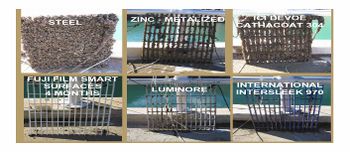Difference between revisions of "Quagga"
From Glen Canyon Dam AMP
(fix) |
(fix) |
||
| Line 20: | Line 20: | ||
<span style="font-size:85%>Oxygen Deprivation | Temperature Treatments | Exposure and Dessication| Ultraviolet Radiation | Manual Scraping | High-pressure Jetting | Mechanical Filtration | Passive and Barrier Filtration | Removable Substrates | Chemicals ('''Chlorine''') or Molluscicides | Ozone | '''Antifouling Coatings''' | Electric Currents| Sonic Vibration | Natural Predators or Biological Controls| Bacteria ('''Pseudomonas Fluorescens''')</span> | <span style="font-size:85%>Oxygen Deprivation | Temperature Treatments | Exposure and Dessication| Ultraviolet Radiation | Manual Scraping | High-pressure Jetting | Mechanical Filtration | Passive and Barrier Filtration | Removable Substrates | Chemicals ('''Chlorine''') or Molluscicides | Ozone | '''Antifouling Coatings''' | Electric Currents| Sonic Vibration | Natural Predators or Biological Controls| Bacteria ('''Pseudomonas Fluorescens''')</span> | ||
| − | |||
| − | |||
| − | |||
| − | |||
| − | |||
| − | |||
=='''Quagga Mussel Information''' == | =='''Quagga Mussel Information''' == | ||
Revision as of 16:32, 25 March 2014
This is the Quagga Mussle Information Page-
File:Quagga Pic.jpg
300px
Template:Quagga Mussel - Lower Colorado River Basin
Contents
Quagga Facts/ Trivia
What are the Currently Effective Control Methods Used for Mussels?
Methods of Control:[1] Oxygen Deprivation | Temperature Treatments | Exposure and Dessication| Ultraviolet Radiation | Manual Scraping | High-pressure Jetting | Mechanical Filtration | Passive and Barrier Filtration | Removable Substrates | Chemicals (Chlorine) or Molluscicides | Ozone | Antifouling Coatings | Electric Currents| Sonic Vibration | Natural Predators or Biological Controls| Bacteria (Pseudomonas Fluorescens)
Quagga Mussel Information
Zebra VS Quaggas:
- Quaggas are the dominant species of the two and will displace Zebras.
- Quaggas tolerate colder temperatures, and are more abundant at greater depths, reproduce at lower temperatures, and are more likely to grow in single layers and produce more patchy distributions.
- Unlike Zebras, Quaggas don't necessarily need hard substates to attach and grow. They can grow on the soft, silty bottom sediments.
Quagga Mussel Archive
- JS-Online_Quagga Video link_Affects to the shore line of Great Lakes
- 080706_Suntimes_Lake Invader Hurts Fish Population & Fouls Shores
- 080715_Sky High_Lake Grandby Colorado samples test positive for invasive quagga mussel
- 080624_Quagga Testimony before the US House of Representatives_MET-DeLeon
- 080620_LVRJ_Mussels Last Meal- Bacteria
- 080603_USBR_Quagga Task Force Meeting Presentation
- 080509_Quagga Video Feed at Fish Hatchery
- 080509_LVRJ Fish Hatchery Victim of Mussels
- 080509_LVRJ_Lake Tahoe Boats Face Scrutiny for Invasive_Mussels
- 080415_Quagga Status Report for CRC Customer Meeting
- 080502_USBR_Future O&M Implications- LCR
- 080501_LVRJ_Bill Allows Partnerships to Fight Invasive Species
- 071005 USGS- Dreissena Risk Assessment for the Colorado River Ecosystem
- 070912 TRC_Quagga Presentation- Assessment of Potential Impacts- Recommendations for Hoover & Parker-Davis
- 070905 US Fish and Wildlife Quagga Mussel Report
- 070721 LVSun Get Rid of Pests- Not if it turns tap water pink- Quagga Mussels
- 070717 USBR Hoover- Quagga found in Needle Valve Area of Generator N-0
- 070628 USBR Quagga Up-Date at Parker
- 070401 USBR Discovery of Quagga- Lower Colorado River & Implications for the Future Dams and Facilities
- 070131 USBR News Release- Quagga found on Hoover Intake Tower and Below Dam
- 070119 LVRJ -Water Invasion Mussels
References
The Bureau of Reclamation- Quagga web-page
